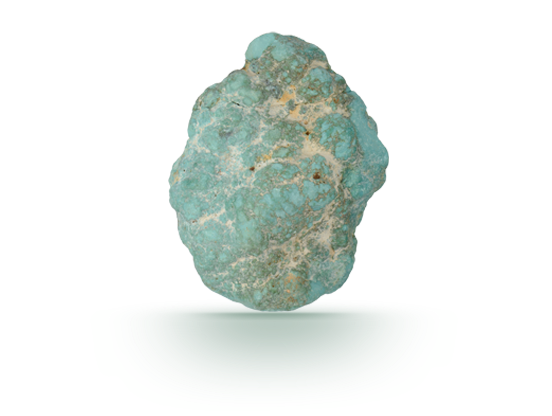OVERVIEW
Turquoise is found in only a few places on earth: dry and barren regions where acidic, copper-rich groundwater seeps downward and reacts with minerals that contain phosphorus and aluminum. The result of this sedimentary process is a porous, semitranslucent to opaque compound of hydrated copper and aluminum phosphate.
Turquoise is found in only a few places on earth: dry and barren regions where acidic, copper-rich groundwater seeps downward and reacts with minerals that contain phosphorus and aluminum. The result of this sedimentary process is a porous, semitranslucent to opaque compound of hydrated copper and aluminum phosphate.
Turquoise is a prime example of an opaque colored stone that can be marketed both as a gem for jewelry and as an ornamental material.
Turquoise might lack the sparkle and clarity of transparent colored gemstones like ruby, emerald, and sapphire, but its multi-layered history and soul-satisfying color make it a desirable gem. Its color can range from dull greens to grass greens to a bright, medium-toned, sky blue. People value turquoise highly for its combination of ancient heritage and unforgettable color.
The traditional source for the top color, sometimes described as robin’s-egg blue or sky blue, is the Nishapur district of Iran, the country formerly known as Persia. So, quite often, you’ll hear people in the trade call turquoise of this beautiful color “Persian blue,” whether or not it was actually mined in Iran.
Top-quality turquoise has inspired designers to create elegant jewelry. It’s most often cut into cabochons, but it might also be cut into beads or flat pieces for inlays.
Although much turquoise jewelry is sleek and modern, many US consumers are familiar with the traditional jewelry of Native American peoples such as the Pueblo, Hopi, Zuni, and Navajo. People interested in Native American arts and crafts frequently collect this stylized silver jewelry.
Turquoise is relatively soft, so it’s ideal for carving. Artists in Europe, Asia, the Middle East, and the Americas choose turquoise as a medium for carved jewelry and art objects. It’s often fashioned into talismans with Native American significance, such as bird and animal carvings, called fetishes.
- Mineral: Turquoise
- Chemistry: CuAl6(PO4)4 (OH)8.5H2O
- Color: Blue to green
- Refractive Index: 1.610 to 1.650
- Birefringence: Not detectable
- Specific Gravity: 2.76 (+0.14, -0.36)
- Mohs Hardness: 5 to 6
WHERE IS IT FOUND ?
Turquoise has been mined in the Nishapur district of Iran for more than 1,000 years. The prized even-colored, intense blue turquoise from this region is dubbed “robin’s egg blue,” “sky blue” and “Persian blue.” Trade professionals now use these terms to describe turquoise of this color – regardless of the source.
Although New Mexico was the largest producer of turquoise in the U.S. until the 1920s, today most of the U.S. production of this December birthstone comes from Arizona and Nevada. Mines have evocative names like Dry Creek, Easter Blue, Emerald Valley and Fox. The Kingman mine in Arizona is a historically important source that is known for producing intense blue turquoise. Now closed to turquoise mining, Arizona’s Sleeping Beauty mine was a prolific producer for more than four decades.
Today, China is the world’s largest producer of this December birthstone. Hubei Province, in central China, is the source of most of the gem-quality turquoise currently being mined there.
CARE & CLEANING
Some turquoise is treated to improve its durability (it has a Mohs hardness of 5 to 6), appearance and polish. Turquoise can be dyed or chemically enhanced by adding an epoxy or acrylic resin for greater hardness or better color. Also seen are cavities filled with a metal-loaded epoxy to imitate pyrite inclusions.
Turquoise is generally stable to light, but high heat can cause discoloration and breakage. Your turquoise birthstone can be damaged by acids, and it can be discolored by certain chemicals, cosmetics and even skin oils or perspiration. It’s safe to clean turquoise jewelry with warm, soapy water, but this December birthstone should never be cleaned with steam or ultrasonic cleaners. Heat or solvents can damage the treated surfaces on some turquoise.
BIRTHSTONE
Turquoise is the traditional birthstone for the month of December and the gem of the 11th anniversary.
HISTORY
Turquoise is one of the world’s most ancient gems. Archaeological excavations revealed that the rulers of ancient Egypt adorned themselves with turquoise jewelry, and Chinese artisans were carving it more than 3,000 years ago. Turquoise is the national gem of Tibet, and has long been considered a stone that guarantees health, good fortune, and protection from evil.
The gem’s name comes from the French expression pierre tourques, or “Turkish stone.” The name, which originated in the thirteenth century, reflects the fact that the material probably first arrived in Europe from Turkish sources.
Turquoise was a ceremonial gem and a medium of exchange for Native American tribes in the southwestern US. They also used it in their jewelry and amulets. The Apaches believed that turquoise attached to a bow or firearm increased a hunter’s or warrior’s accuracy.
Turquoise is plentiful and available in a wide range of sizes. It’s used for beads, cabochons, carvings, and inlays. Although well known to consumers, its popularity in the mainstream jewelry industry comes and goes. The biggest and most permanent market is in the American Southwest. It’s also popular elsewhere, among customers who are captivated by that region’s mystery and romance, as well as by the blue of its skies.
In the United States, turquoise is one of the birthstones for December. (Zircon is the other option for that month).
Source of Content : www.gia.edu


